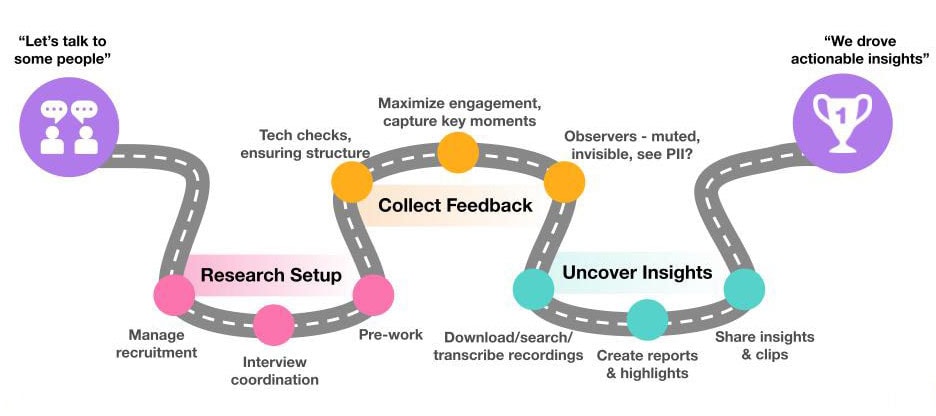Discuss’s Jim Longo looks back at 2021 and at the road ahead in 2022

Just a few years into the 2020’s and the decade is proving to be more unpredictable than ever for market research and insights, a true reflection of how disruption and new technologies have reshaped our lives by moving so much online.
Through such an accelerated digital transformation as a result of the pandemic, it’s become clear that there’s no going back. Just as lifestyles have changed, so too has the way that CX, UX and insights teams have conducted research.
Looking back at these seismic shifts, Discuss co-founder and Chief Strategy Officer Jim Longo shares his perceptions of how everything has changed in the past year and what to anticipate in 2022.
Discuss: What are the major MRX trends that dominated the industry in 2021? Have there been any surprises?
Jim: Online qualitative research has become a respondent equalizer. Because of the digital shift through and beyond the pandemic, researchers are able to connect with more people in more difficult-to-reach locations and on respondents’ time, providing more diversity in consumer voices. The level of intimacy of online conversations when respondents are speaking in their homes has been a surprise — this has offered up a new avenue for ethnographic research. It’s been interesting to see how open respondents are to speaking with researchers through the pandemic and during social isolation. And we’ve been surprised to see how easy it’s become to coordinate focus groups than it was 5, 10, and certainly 20 years ago.
Another major trend is the combining of quantitative and qualitative research: In 2019, the typical split was 80% quantitative and 20% qualitative. Now, 50% of all projects have a qualitative component before, during or after quantitative research takes place. I think this has become the norm now that we have the technology to more quickly deliver insights at scale. For insights platforms like Discuss, AI-enabled insights extraction has been the key to unlocking this level of qualitative data collection. As a result of these new dynamics, customer empathy has become not just a strategy but a KPI.
Discuss: How will the pandemic have long-lasting effects on the MRX industry? In your opinion, are in-person focus groups now completely obsolete?
Jim: While the interest in online qualitative research had ebbed and flowed since the Great Recession, when more companies needed to cut overhead costs and moved operations online, this recent wave of interest can only grow as the technology and functionality have advanced to the point of, in many cases, adding more value than in-person sessions.
However, I don’t think that in-person focus groups will ever become obsolete, as it’s critical to reach respondents from all walks of life — including those that have limited access to online platforms or issues with connectivity.
Discuss: What were the major pain points this year? Do you see these issues being addressed anytime soon?
Jim: Dealing with the ripple effects of the pandemic, for one. Additional disruptions to the economy, including labor shortages and supply chain interruptions, have required brands to stay connected with consumers to predict their next moves. The result of all this is that there’s been a greater understanding that making customers happy can’t happen without empathy. And there’s no better way to gain both empathy and customer closeness than through talking to people and getting a sense of their lifestyle and what makes them tick through qualitative research.
Discuss: Overall, do you think 2021 was a good year for the MRX industry?
Jim: Qualitative research was such a growing part of all research initiatives in 2021, and now that we have the technology to provide structure to previously unstructured data, essentially providing qualitative insights at scale, there is a growing need to dive deeper to get a holistic view of people’s experiences.
I think that the new capabilities that technology has unlocked has been a huge leap forward for market research, as well as for customer and user experience teams. Ultimately, through the ability to quickly gain insights from people, we’ll find more benefits to end users or customers, as brands will be able to serve them better.
Since we now have the technology for insights at scale, companies should look to democratize the sharing of insights, as this technology can enable the VoC to really drive outcomes across the business.
Discuss: Looking to the future, what do you foresee as the next big trend(s) to evolve within MRX in 2022?
Jim: Market research as we know it will come out of the silo and become a shared project of CX, UX and Insights.
Historically, CX was driven by quantitative analysis, but now that qualitative research is being brought into the fold, we’re seeing that CX and Insights teams are reporting up to the same person in an organization.
(See our key takeaways from TMRE Nashville for more on this trend).
In addition, the gathering of asynchronous or unmoderated online customer feedback has been growing for years, and it’s going to become more common through 2022 and beyond. We expect to see a combining of both self-captured and live video sessions to get more authentic and dynamic responses from participants. And the advancement of mobile qualitative research, such as our mobile screen share for digital shop-alongs, will offer yet another avenue for customer feedback that is more convenient for participants.
Discuss: How can other players in the industry and/or brands begin to act on these trends now to get ahead of the curve?
Jim: Companies can find the intersection of the work that their insights team, CX and/or UX leaders are doing and find alignment to develop strategies for greater customer closeness. And they should be focused on defining the empathy and closeness gaps they see within their organization. Since we now have the technology for insights at scale, companies should look to democratize the sharing of insights, as this technology can enable the VoC to really drive outcomes across the business.
‘
Jim Longo is the Co-Founder and Chief Strategy Officer at Discuss, a consumer-connection platform for market research. He brings over 25 years of domain expertise in the market research industry. Jim is considered a thought leader with regards to online behavior and market research technology. He has consulted with brands and research agencies around the world on how to have insightful online conversations and was instrumental in building the first global online qualitative research practice at Harris Interactive (acquired by Nielsen). There, he led a team that conducted more than one thousand online groups in the first three years of its existence.
Sign Up for our Newsletter
Related Articles

3 Steps to Faster Insights
Same-day deliveries and two-day shipping have changed our expectations as consumers. Just as we expect our essentials or last-minute gifts…
Same-day deliveries and two-day shipping have changed our expectations as consumers. Just as we expect our essentials or last-minute gifts…

3 Common Mistakes to Avoid in Qualitative Session Setup
Qualitative research sessions often have a lot of moving pieces even before a session can begin. Take, for example, a…
Qualitative research sessions often have a lot of moving pieces even before a session can begin. Take, for example, a…

3 Key Takeaways from “Rethinking the Agile Manifesto for Research” Webcast
In the recent webcast, “Rethinking the Agile Manifesto for Research – And How to Put Experience at the Center,” Forrester…
In the recent webcast, “Rethinking the Agile Manifesto for Research – And How to Put Experience at the Center,” Forrester…

